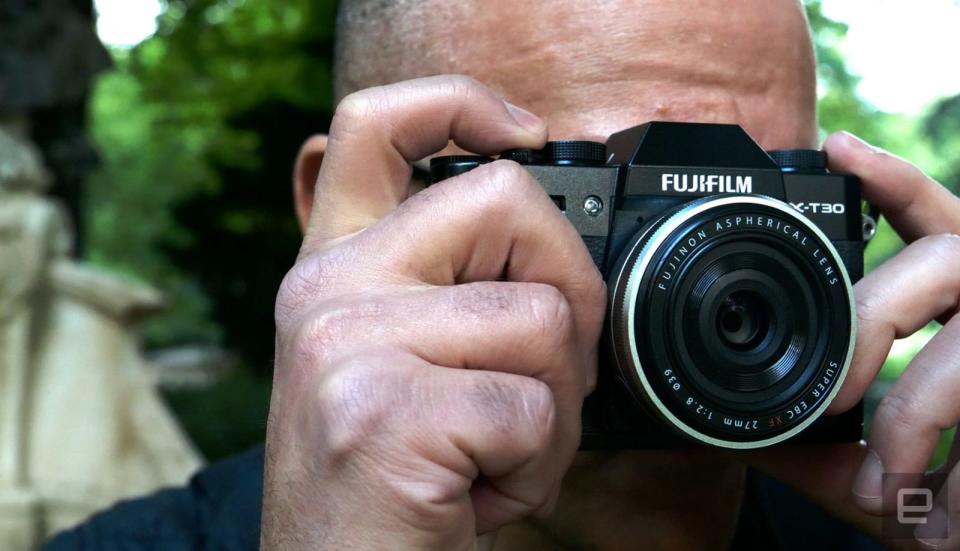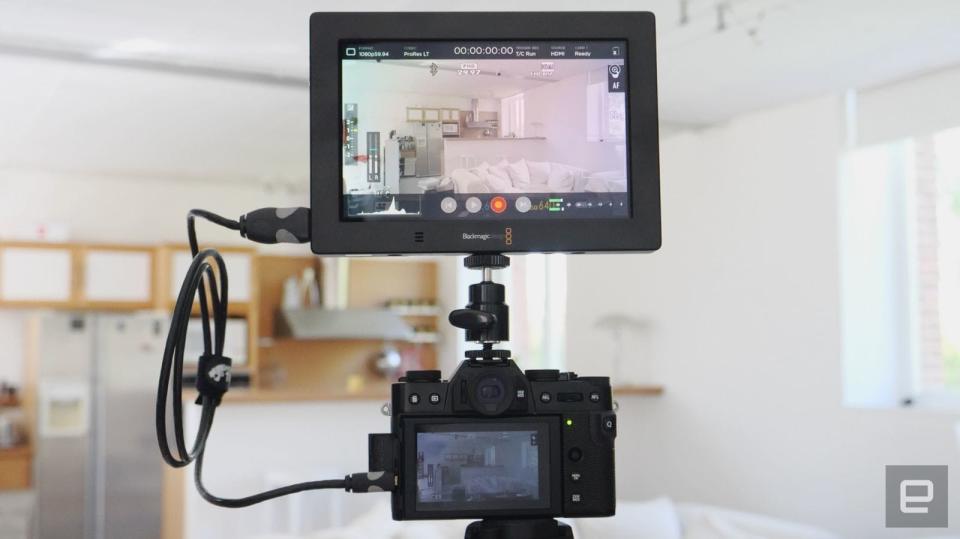Fujifilm X-T30 review: A street photography and 4K-video champ
Most of the benefits of the X-T3 for $600 less.
Amid all the drama in the full-frame mirrorless camera world, Fujifilm quietly unveiled the world-beating APS-C sensor X-T3, last fall. With an all-new 26.1-megapixel X-Trans 4 backside-illuminated (BSI) sensor, it was a major improvement on the X-T2 in speed, autofocus capability, ergonomics and, especially, video. Then, to further press its advantage on Sony, Fujifilm subsequently launched the X-T30 with the same sensor and image quality as the X-T3, for $600 less. Despite that price gap, the X-T30 is packed with features. It has full APS-C 4K video, shooting speeds up to 30 fps and AI-powered face- and eye-detection autofocus. All of that is squeezed into a lightweight, well-designed body that's ideal for travel and street photography. You can't have everything, though, so the X-T30 is missing some features found on its higher-end sibling. To find out how it would fare against rivals, like Sony's A6400, I took it for a spin on the streets of Paris. The X-T3 was already pretty compact for an APS-C mirrorless camera, but the X-T30 is downright small. It's just 383 grams (.85) pounds, less than the 403-gram Sony A6400. In fact, with a 27mm pancake lens, it weighs around the same as Fujifilm's $1,299 X100F compact. The main reason is it's not weather sealed like the A6400, but I don't think that's too important for its target market. The X-T30 has a much smaller (borderline nonexistent) grip than the A6400. While that means it might slip out of your hands more easily, the narrower width makes it easier to slip into a pocket. The smaller grip also works better if you're holding the camera low and "shooting from the hip" for street photography. The X-T30 is a well-designed camera -- except for the bottom part. The tripod socket is placed off the lens axis and too close to the battery compartment, so you have to take it off before you can remove the battery or memory card. Once you do, it's hard to pop out the card, as the slot is too close to the compartment's lid. Apart from that, the ergonomics are outstanding. It has front and rear control dials to adjust settings like ISO and aperture, and top dials for exposure compensation, shutter speed and shooting settings. You also get the aperture dial that's present on most Fujifilm X-series lenses. All of those controls make the X-T30 a very tactile, fun-to-use camera. It now has a joystick rather than a D-pad like its predecessor, the X-T20. I guess you don't need one when you've got the other, but it seems like there's room for both. Fujifilm also moved the Q button, which lets you easily access the most-used functions, so it's now in an awkward, easy-to-bump spot. I found the OLED EVF to be middling, with 2.36 million dots of resolution and 100 fps maximum refresh rate. To be fair, though, it's the same as the one on Sony's A7 III, which costs $1,100 more. On the plus side, it has blackout-free performance during continuous burst shooting, beating Canon's more expensive full-frame EOS RP. The rear display is now a touchscreen, letting you select the focus point and control Q settings. You can't control the main menu functions like on new models from Canon, Nikon and Blackmagic Design, however. You can tilt up or down the rear display, but not flip it around. That makes it good for street shooting, but not vlogging, unfortunately. The menu system on Fujifilm cameras is logical, and it's pretty easy to find important settings. The Q menu is your best bet for ease of use and lets you program a lot of different settings. One minor complaint: I don't like Fujifilm's individual max auto ISO settings (A6400, A3200 etc.) as they're too easy to mix up with the main ISO settings (yes, I did this, and, yes, it resulted in a lot of blurry shots). I'd rather just have a single auto ISO setting, with the ability to select the maximum ISO in another setting. Moving to the ports, Fujifilm has done something interesting. While there's no headphone jack, the USB Type-C port works with USB headphones (bundled with many smartphones nowadays) or a USB to 3.5mm adapter. That's a pretty clever solution on a compact camera and made the X-T30 a lot more useful when I shot video. It also has a microphone port (2.5mm, so you'll need an adapter) and micro-HDMI port. The latter is more useful than video shooters might expect, as you'll soon learn. The smallish 8.7 Wh battery delivers 380 shots on a charge, and I found I was able to shoot for nearly a day. However, recording video drains the battery fast, so you'll need at least a couple of spares if you're doing that. The single card slot (slower SD UHS-I only, unfortunately) is in the battery compartment. Two UHS II slots would be nice, but then that's why you pay $1,500 for the X-T3. Sony's A6400 has the same card-slot system and battery life that's slightly worse. For its size and category, the X-T30 delivers stellar shooting performance. You can shoot at 8 fps with the mechanical shutter enabled, and 20 fps using the (silent) electronic shutter. If you're okay with a 1.25 times crop, you can hit an incredible 30 fps in electronic shutter mode. The buffer is pretty small, so you'll be able to fire off about 17 RAW frames before continuous shooting stalls. With a fast card in JPEG-only mode, I was able to shoot for a good 13 seconds (around 104 shots) before saturating the buffer. That let me capture some great sequences, like a child riding a bike through a shallow pond. With 425 phase-detect AF tracking points covering 99 percent of the sensor, and 117 hybrid phase and contrast detect areas, the autofocus system can keep up with those speeds. Single-shot AF is deadly, nailing focus nearly 100 percent of the time. I also got an excellent hit-rate on regular center- or flexible-point continuous autofocus if I kept the tracking square on the subject. Surprisingly, the X-T30 had more advanced AI-powered face and eye-tracking than the X-T3 at launch, though the latter has now caught up with a firmware update. Specifically, the X-T30 now lets you switch between subjects by selecting them on the touchscreen and can detect faces and eyes from farther away than its more expensive sibling. I found that it worked very well but didn't stick to faces as tenaciously as the A6400. Rather, it tended to jump around with multiple people in a shot. Nevertheless, in most shooting situations, I got a very high percentage of in-focus shots both in regular and eye-tracking modes. This makes it great for street, casual and portrait shooting, and crucially, it has a truly silent shutter speed, to boot (take that, EOS RP). The biggest drawback of the X-T30 is it lacks in-body stabilization, unlike Panasonic's similarly priced G95. However, the G95 has a smaller Micro Four Thirds sensor with less shallow depth of field, and the X-T30's main APS-C rival, the A6400, also lacks that feature. If you need it for video or low-light photography, you'll have to get a stabilized (OIS) lens. Luckily, Fujifilm has plenty to choose from. I had hoped that the X-T30 would pack at least decent video features, but Fujifilm far exceeded my expectations. Rather than cropping or line-skipping, it uses the entire 6K sensor and supersamples it to 4K at up to 4,096 x 2,160 DCI resolution. As a result, I was able to shoot sharp, artifact-free 4K video on par with the X-T3. It's limited to 30p, rather than 60p 4K video like the X-T3, but that's not surprising for a mid-range camera. You can, however, shoot 1080p at 60p with no crop (and autofocus enabled) and 120 fps with a 1.29 times crop. Those specs are nearly identical to Sony's A6400 (and the $1,200 A6500, too, for that matter), except that the X-T30 can handle higher-resolution DCI and shoot at double the A6400's 100 Mbps data rate. That makes for less MPEG blockiness, particularly in detailed scenes with lots of camera movement. There are some compromises, of course. Video records internally at 8-bit, rather than 10-bit, giving you fewer color-correction options when editing. The X-T3 also has a 400 Mbps data rate available with frame by frame (all-intra), rather than MPEG interframe encoding. Cutting through the jargon, that makes it a lot easier, and faster, to edit video. To my great surprise, the X-T30 supports 10-bit 4K output from the micro-HDMI port to an external video recorder. That let me capture professional Apple ProRes video with more color detail to my $495 Blackmagic Video Assist. The reward was more choices in the edit studio, especially with poorly exposed footage. As mentioned, another nice surprise is you can MacGyver a headphone output using the X-T30's USB Type C port. That makes it a viable option for shooting interviews, vaulting it ahead of any other mid-range mirrorless APS-C camera, Sony's A6400/A6500 included. To get that option on another model, you'd have to spend $1,300 on Canon's full-frame EOS RP, or around $1,000 on the Sony A7 II, which can't shoot 4K. Video autofocus is solid. Thanks to the hybrid phase-detect system, it locks on with less of the hunting I got with Panasonic's GH5s, for instance. Face and eye detection works well, too, though it's not as fast and accurate as the canny system on Sony's A6400. And unfortunately, unlike the latter model, subject tracking only works with faces, so you can't track animals, cars or distant humans. Another limitation is the continuous recording time, just 10 minutes compared to unlimited for the A6400. However, rolling shutter is far better controlled on the X-T3 compared to the bad jello effect on Sony or Canon APS-C models. Overall, I would recommend the X-T30 above any midrange model -- APS-C or full-frame -- for price-conscious video shooters. As for photo image quality, the X-T30 packs the same 26.1-megapixel X-Trans sensor as the X-T3, so I found that it delivered the same sharp, color-accurate images. With backside illumination, you get usable shots at up to about ISO 12,800, with well-controlled noise levels and little loss of saturation. While it doesn't have the same low-light performance as Sony's full-frame A7 III camera, it matches what the A6400 can do. When shooting JPEGs, the X-T30 delivered accurate colors, especially in the skin tones. RAW dynamic range is also at a high level, on par with the A6400. That gives you a lot of room to bring up shadow detail and recover highlights on under- and overexposed shots, with well-controlled noise levels at up to ISO 3200. When I wanted to get more artsy, the X-T30 gave me a full range of film-simulation modes, including Velvia, Eterna and Monochrome. These draw on Fujifilm's film experience (Velvia is a well-known 35mm film brand), so they're very effective and not gimmicky, like on other cameras. If anything, I'm even more impressed with the X-T30 than I was with the X-T3, particularly in light of the price. While it's missing some features, it delivers the same outstanding image quality and actually has superior autofocus performance, at least until the X-T3 gets a firmware update. Video, in particular, is a huge bonus, with features like full-sensor DCI 4K video and 10-bit external output not found on cameras that cost triple the price. At $900, the X-T30's closest rival is the Sony A6400. The latter has superior face- and eye-tracking and features like subject-tracking and animal eye-tracking that beat the X-T30. However, Fujifilm is catching up to Sony in this area, and I think the X-T30 wins in terms of 4K video, handling and looks. Another option in this price range is Panasonic's new G95. It offers in-body stabilization, a better EVF and a flip screen for vlogging. However, the X-T30 has superior autofocus, video options and handling, and costs $999 with a kit lens, compared to $1,199 for the G95.
Body

Performance

Video


